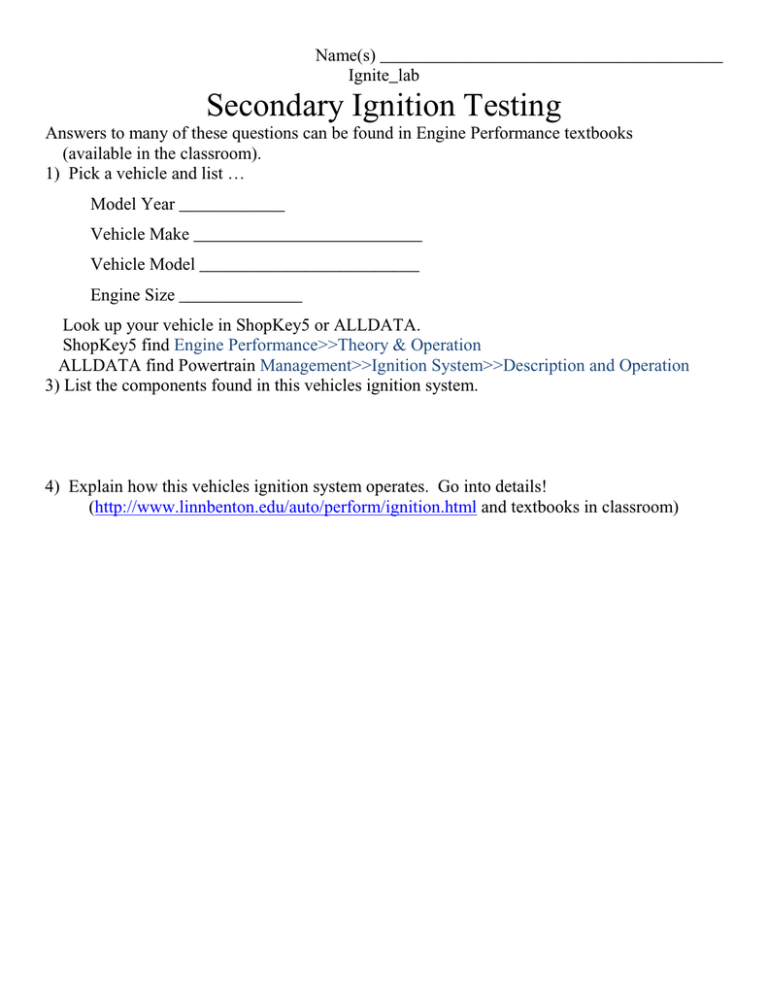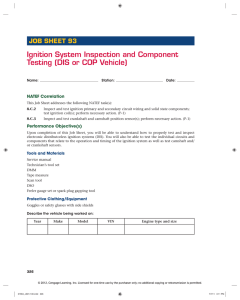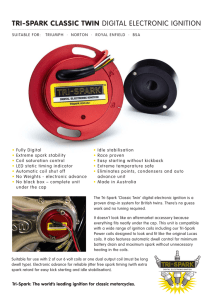Secondary Ignition Testing
advertisement

Name(s) _______________________________________ Ignite_lab Secondary Ignition Testing Answers to many of these questions can be found in Engine Performance textbooks (available in the classroom). 1) Pick a vehicle and list … Model Year ____________ Vehicle Make __________________________ Vehicle Model _________________________ Engine Size ______________ Look up your vehicle in ShopKey5 or ALLDATA. ShopKey5 find Engine Performance>>Theory & Operation ALLDATA find Powertrain Management>>Ignition System>>Description and Operation 3) List the components found in this vehicles ignition system. 4) Explain how this vehicles ignition system operates. Go into details! (http://www.linnbenton.edu/auto/perform/ignition.html and textbooks in classroom) A vehicle that has no spark may have a defect in the Primary or Secondary Ignition System. Using a 12 volt test lamp you can verify that the primary ignition system is getting the proper signal to turn On and Off. Details on how to do this test are at: http://www.linnbenton.edu/auto/perform/how_spark.html#test_light Practice using a 12 volt test lamp to see the operation of the primary ignition systems. 5) Discuss how the ignition system for your vehicle operates and demonstrate testing the primary ignition system with a 12 volt test lamp. 6) Demonstrate how a 12 volt test lamp can be used to verify that the primary ignition system is working. ___ I have been checked by the instructor for #3, #4, #5, & #6 above ___ I have NOT been checked by the instructor If the primary ignition system is switching On and OFF as verified by your test lamp, the cause of no spark must be in the ignition coil, or the secondary ignition system. 7) List every component found in your vehicle’s secondary ignition system. Read about Testing Ignition Coils at www.linnbenton.edu/auto/perform/ignition.html#test_coil 8) How can an ohm meter find a defective ignition coil? 9) If the ignition coil resistance measures to within specifications, why does this not guarantee a good ignition coil? 10) When ignition coils heat up, the resistance for the windings will __ Increase __ Decrease Locate and record the specified resistance for the Primary and Secondary coil(s). Primary Coil specified resistance ___________________________ Secondary Coil specified resistance ___________________________ Specified temperature of coil ______________ Measure and record the actual resistance of one ignition coil. Primary Coil measured resistance ___________________________ Secondary Coil measured resistance ___________________________ Measured temperature of coil ______________ (ask for the infra-red thermometer) Read Testing Spark Plug Wires at www.linnbenton.edu/auto/perform/ignition.html#test_wire 11) Why do spark plug wires often have several thousand ohms of resistance? 12) Look up and record the Specified resistance for the spark plug wires. 13) Measure and record the actual resistance of each high tension wire for one complete spark path. (If this is a distributor system that will include the coil wire and one spark plug wire.) (If this is a waste-spark system that will include the two spark plug wires leading from one coil) 14) If you find one defective wire, why should you replace the entire set of plug wires? Sometimes the spark can short out under damp or wet conditions. Using a spray water bottle to mist around the spark plug wires, ignition coil and distributor cap while the engine is running can help identify secondary ignition system insulation that is failing and allowing the spark to follow a short circuit instead of jumping the spark plug gap. TRY THIS! Demonstrate ... Primary coil resistance ... Secondary coil resistance… Plug wire resistance … …Visual inspection of secondary ignition components ... Use of di-electric grease on wires. ___ I have been checked by the instructor ___ I have NOT been checked by the instructor One common defect for secondary ignition systems is spark plugs that have become fuel or oil fouled, or are just plain worn out. Worn spark plugs will increase their gap AND the center electrode will become rounded. Review the information on spark plug removal and replacement at: http://cf.linnbenton.edu/eit/auto/krolicp/web.cfm?pgID=6709 Also watch part of the video below… http://www.youtube.com/watch?v=LtQ0LV7u1OE&feature=related (Start at 6:30 and watch through 8:30 2 minutes of Good Advice!) 15) Why should you blow compressed air around the spark plug before removing it? 16) If there is oil leaking onto the spark plug wire boots, why is important to recommend repairing that leak to the customer? (What will the leak cause other than loss of oil?) 17) Where do you use di-electric grease when replacing spark plugs New spark plugs need no ant-seize on the threads however when re-installing the old spark plugs I recommend using a very small amount of anti-seize on the spark plug thread. 18) Why is using too much anti-seize on a spark plug a bad thing to do? 19) Look up and record the specified spark plug gap, and torque specification. (List specifications here) Remove one or two spark plugs (each lab partner must do this!). Check the plug gap with the proper tool. Practice using a rubber hose to help re-install the spark plug. Use a torque wrench to re-install the plug. Demonstrate proper spark plug service for …. ___ I have been checked by the instructor There are 3 basic types of secondary ignition systems, Distributor, Waste Spark (Distributorless) and Coil-On-Plug. Find one of each type and briefly explain the secondary ignition components of each system to the instructor ___ I have been checked by the instructor



